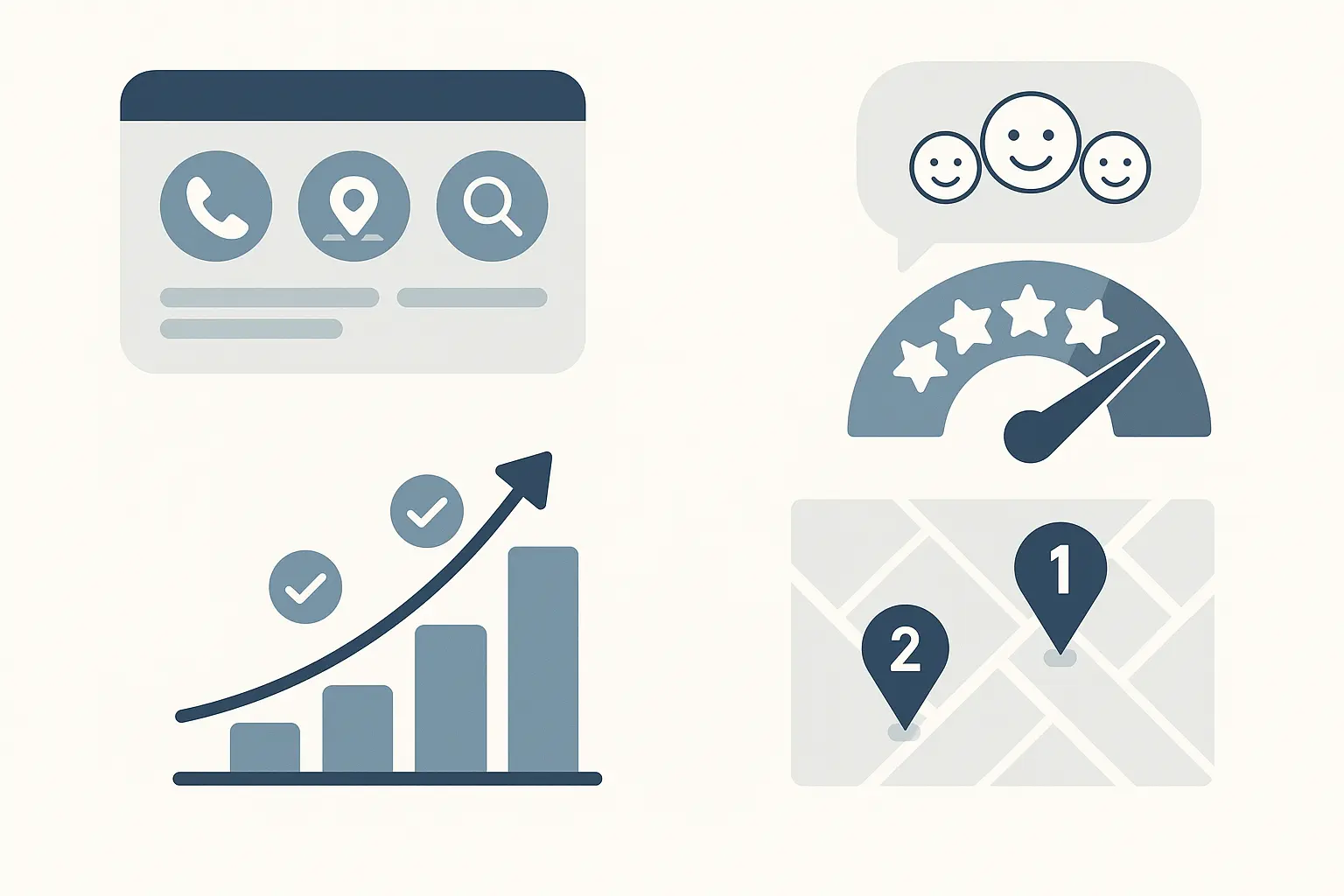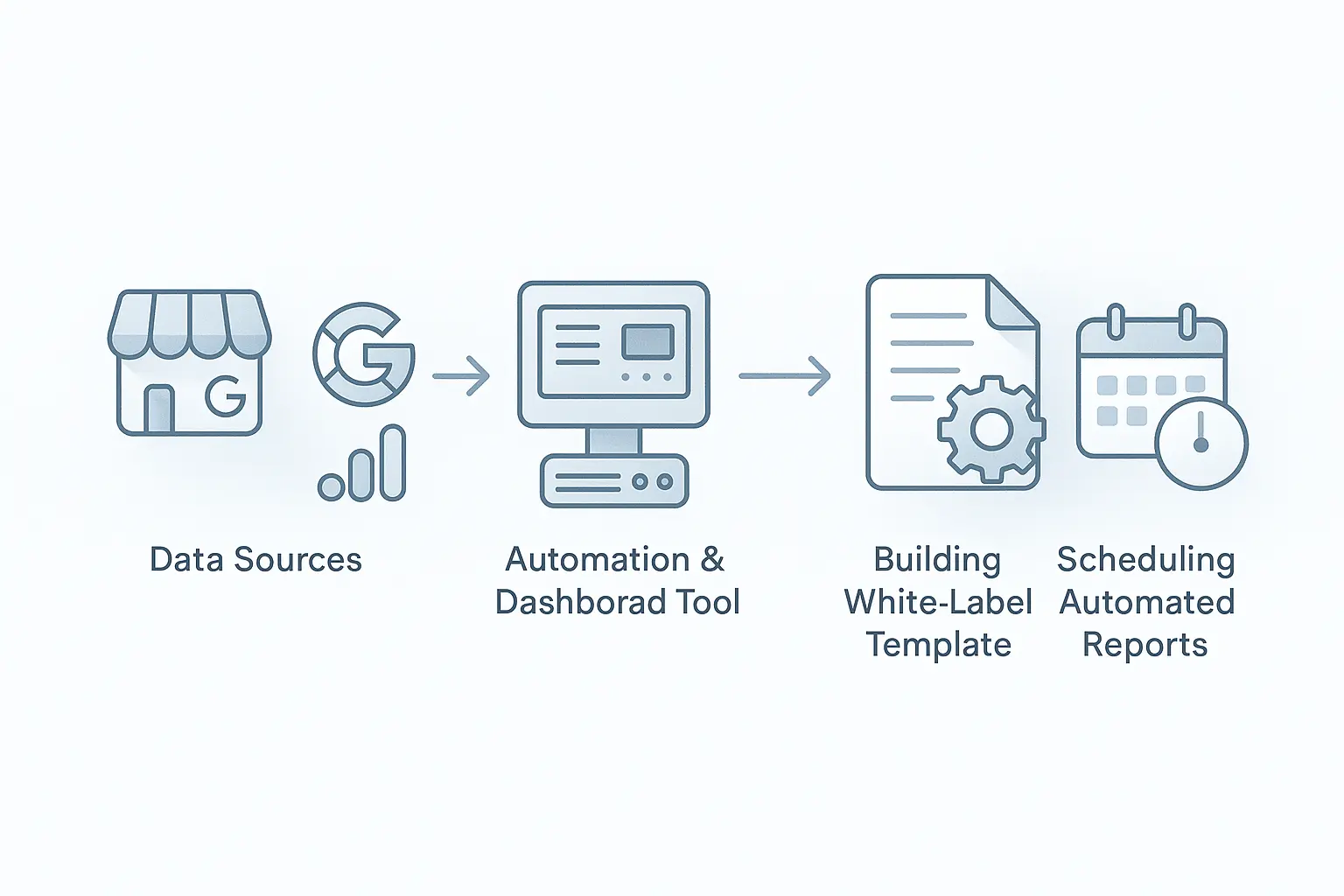You did everything right. You optimized your client’s Google Business Profile, built a dozen new citations, and even nudged their “near me” rankings up a few spots. You send over the monthly report, proud of the green-arrow progress.
Then, the client calls. “The report looks fine, but… isn’t the phone supposed to be ringing more?”
That question gets to the heart of a fundamental gap. Standard SEO reports, focused on rankings and traffic, often fail to measure what a local business truly cares about: phone calls, direction requests, and new customers walking through the door. Research shows that 46% of all Google searches are for local information, and if your reporting isn’t capturing that local intent, you’re not telling the whole story.
It’s time to stop reporting on vanity metrics and start delivering insights that connect your SEO work directly to your client’s bottom line.
The Blind Spot in Generic SEO Reporting
For a local plumber, dentist, or restaurant, ranking #1 for a keyword in a city 50 miles away is useless. Their success hinges on hyperlocal visibility. Generic tools are great for tracking broad keyword rankings and overall website traffic, but they often miss the metrics that define local success:
- Google Business Profile (GBP) Actions: How many people clicked to call or requested directions straight from the search results?
- Local Pack Visibility: Are you showing up in the coveted “map pack,” where 75% of local searchers never click past the first page?
- Citation Health: Is the business’s name, address, and phone number (NAP) consistent across the web, or are old addresses confusing Google and potential customers?
Reporting on local SEO with a generic template is like trying to measure rainfall with a thermometer. You’re using the wrong tool for the job, and the data you get is just as misleading.
The Metrics That Actually Matter for Local Clients
To show the true value of your work, your reports need to be built around the unique Key Performance Indicators (KPIs) of local search. Think of these as the three pillars of a world-class local SEO report.
1. Google Business Profile Performance: The Digital Storefront
Your client’s GBP listing is their new homepage. It’s often the first—and sometimes only—interaction a customer has with their business online. Since 64% of consumers have used GBP to find contact details for a local business, your report needs to treat it like the mission control center it is.
Key GBP Metrics to Track:
- Search Views (Direct vs. Discovery): Are people finding your client by searching their business name (Direct), or by searching for a category, product, or service they offer (Discovery)? A rise in Discovery searches shows that your SEO efforts are expanding their reach to new customers.
- Customer Actions: This is where the magic happens. Track the number of website clicks, direction requests, and phone calls coming from the GBP listing. These aren’t just clicks; they’re high-intent leads.
- Photo & Post Engagement: Just like a physical storefront, an engaging digital one attracts more customers. Tracking views on photos and engagement with GBP posts shows how well you’re curating their online presence.

2. Citation Velocity & Consistency: The Digital Footprint
Think of citations as online mentions of your client’s business NAP (Name, Address, Phone number) on directories like Yelp, Yellow Pages, and industry-specific sites. Consistency across these listings is crucial, especially since 80% of consumers lose trust in local businesses if they see incorrect or inconsistent contact details online.
But it’s not just about having citations; it’s about building them at a steady, natural pace. This is called Citation Velocity.
A report that simply lists the total number of citations misses the point. A great report visualizes citation velocity, showing the client a steady stream of new, consistent listings being built over time. This demonstrates your ongoing effort to strengthen their digital footprint and build trust with Google.

3. Review Management & Velocity: The Voice of the Customer
Online reviews are the new word-of-mouth and a powerful driver for local business. With 93% of consumers saying that online reviews influenced their purchase decisions, you can’t afford to ignore them.
Your report should go beyond just showing an average star rating.
Key Review Metrics to Track:
- Review Velocity: What’s the rate of new reviews coming in? A healthy velocity signals to Google that the business is active and relevant.
- Average Rating Trend: Is the average star rating improving over time?
- Response Rate: Are you (or the client) responding to reviews? Acknowledging feedback—both positive and negative—builds trust and encourages more of it.
The Scale Killer: Why Manual Reporting Is Holding Your Agency Back
So, how do you get all this crucial data into a clean, client-facing report? For many agencies, the answer is a soul-crushing combination of screenshots, spreadsheets, and hours of manual data entry.
You log into each client’s Google Business Profile, pull the numbers, navigate to your citation tracker, export a CSV, and then try to mash it all together into a presentable format. This process isn’t just inefficient; it’s a direct bottleneck to your agency’s growth.
The time your team spends pulling data is time they aren’t spending on high-value strategy, client communication, or winning new business. It’s impossible to scale when your most valuable resource—your team’s expertise—is trapped in repetitive tasks.
From Data-Pulling to Storytelling: The Power of Automation
This is where automated, white-label reporting templates change the game. By connecting directly to data sources, these systems can automatically pull all the key local KPIs into a single, professional report branded with your agency’s logo.
Instead of spending hours copying and pasting, your team can open a pre-populated report and focus on what truly matters: analysis.
- “We saw a 40% spike in direction requests last month, which coincided with our new GBP posts about the summer sale. Let’s double down on that strategy.”
- “Our citation velocity is strong, but we’ve noticed a competitor is getting more reviews. It’s time to implement a review generation campaign.”
Automation transforms your team from data-pullers into strategic storytellers. It allows you to deliver sophisticated, data-rich reports that prove your value and impress clients, all while freeing up your team to scale your white-label SEO services.

Frequently Asked Questions (FAQ)
What’s the difference between a local citation and a backlink?
A backlink is a clickable link from one website to another, valued for its “link equity” or SEO authority. A citation is simply a mention of a business’s Name, Address, and Phone number (NAP). While some citations include a link, many don’t. Google uses citations to verify a business’s legitimacy and location, which is critical for local rankings.
How often should I send local SEO reports to clients?
Monthly reporting is the industry standard. It provides a consistent cadence to show progress without overwhelming the client, and it’s the perfect frequency for tracking trends in GMB actions, citation velocity, and review growth.
What is a good citation velocity to aim for?
A healthy citation velocity is more about consistency than sheer volume. Building 5-10 new, high-quality citations per month creates a natural growth pattern that search engines favor. A sudden, massive spike can look spammy, while no new citations can signal stagnation.
Can I track my competitors’ GMB performance?
While you can’t access their private GMB “Actions” data (like calls or direction requests), you can monitor their public-facing information. This includes tracking their reviews, monitoring their GBP posts and Q&A sections, and analyzing changes to their primary category and services. This provides valuable competitive intelligence.
Stop Reporting, Start Proving
Your agency’s success depends on your ability to prove your value. For local clients, that value isn’t measured in abstract ranking charts; it’s measured in real-world results.
By shifting your reporting to focus on the metrics that matter—GMB performance, citation velocity, and review growth—you transform your reports from a simple progress update into a powerful story of business growth. Automating this process isn’t a luxury; it’s a strategic necessity for any agency looking to scale.
Ready to see how a streamlined, automated approach can elevate your client delivery? Discover what’s possible when you have a dedicated agency SEO partner powering your results.

